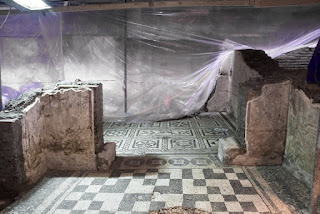Uncovering the Past
Wherever I walk, from my own neighborhood to distant cities, I think about the layers of the past all around me. From street and town names that evoke landscapes and residents of centuries ago to the physical remains of aging and ancient structures, when I look at a place I see not just what is now, but what used to be. This is the job of a historian: to explore the remnants of the past which still remain, to see how the present is built upon layers of past ideas and structures, and to understand how that has shaped our culture and beliefs.
While Romans likely guessed at the rich history hidden beneath their city, unexpected layers of history lay beneath the jungle canopies of Mexico and Guatemala. A recent research initiative using LiDAR - a scanning technology that digitally removes vegetation to reveal the terrain and archaeological remains beneath - to scan vast swaths of the Maya heartland has blown apart existing scholarship on the Maya. The scans have revealed unsuspected neighborhoods in excavated Maya cities, remains of cities and temples previously unknown to scholars, and an extensive network of roads running between them. The Maya population, once estimated to have peaked at five million, is likely to be revised to between ten and fifteen million. All of this had been hidden beneath the jungle canopy for centuries. The vegetation in the region are so thick that archaeologists could - and probably did - pass within feet of these structures without seeing them. By allowing the layers of jungle to be digitally peeled back, this new technology has done work that would have taken centuries using traditional archaeological methods.
Our ideas are also built upon the remnants of the past. The Constitution of the United States is just such a layered. In its original form, it is a product of Enlightenment ideas about human rights and personal freedoms. A product of an era in which privileged white men expounded on the topic of liberty. seeing themselves as disenfranchised by a tyrannical monarchical system. While the outlook of the Founding Fathers may have been self-centered, concerned about their own political and financial interests, the ideas they developed opened the door for the enfranchisement of a succession of new groups. If all men are created equal, then political power ought to be shared with men who did not own property, with Black men, with women, with those old enough to be drafted into the military. As each of these groups demanded a seat at the table, the Constitution was amended to include them. As the names of our city streets reflect successive generations of inhabitants, each layer of the Constitution reflects the changing values of successive generations of Americans.
 |
| Roman military commander's house recently excavated along the Roman Metro's Linea C. Image courtesy of the Soprintendenza Speciale di Roma via the New York Times. |
It is easier to see these layers in some places than others. In Rome, all it takes is a little digging to uncover riches and marvels. The substantial remains existing below the city's surface have stalled the completion of Linea C of the Roman Metro. This subway line, planned in the mid-1990s, only began operating in 2014 and several stations are still unfinished. As the line approaches the historical center of the city, with a station planned near the Colosseum itself, the remains have only gotten thicker. Several years ago, a military barracks from the second century AD was uncovered. In 2018, the remains of a house of a military commander, likely the commander of those same barracks, was uncovered, complete with extensive floor mosaics and wall frescoes. These remains have rested under the feet of Romans for eighteen centuries before new construction revealed them once again.
 |
| LiDAR scan of the Maya city of Tikal in modern-day Guatemala. Image courtesy of National Geographic. |
While Romans likely guessed at the rich history hidden beneath their city, unexpected layers of history lay beneath the jungle canopies of Mexico and Guatemala. A recent research initiative using LiDAR - a scanning technology that digitally removes vegetation to reveal the terrain and archaeological remains beneath - to scan vast swaths of the Maya heartland has blown apart existing scholarship on the Maya. The scans have revealed unsuspected neighborhoods in excavated Maya cities, remains of cities and temples previously unknown to scholars, and an extensive network of roads running between them. The Maya population, once estimated to have peaked at five million, is likely to be revised to between ten and fifteen million. All of this had been hidden beneath the jungle canopy for centuries. The vegetation in the region are so thick that archaeologists could - and probably did - pass within feet of these structures without seeing them. By allowing the layers of jungle to be digitally peeled back, this new technology has done work that would have taken centuries using traditional archaeological methods.
 |
| Constitution of the United States. Wikimedia Commons. |
Remnants of the past are all around, just waiting to be uncovered by those who have the curiosity and the skills to do so. This blog is a place where we can explore and enjoy them together.


Comments
Post a Comment